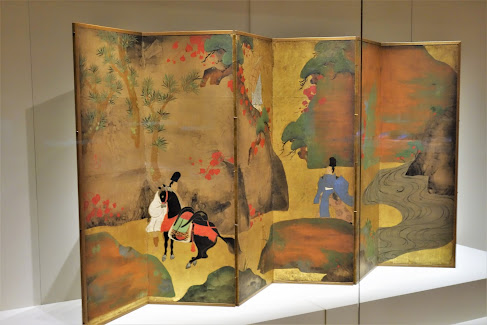The Cleveland Museum of Art's collection of Asian art is highly regarded and considered one of the best in the United States. On my most recent visit to the museum I began an exploration of that collection. We will begin with the art of Japan.
This cooking vessel dating from 2500 B.C, is typical in design from those of that era. They are called "fire-flame vessels" because of the decoration resembling flames.
This bronze bell dates from between A.D. 100 and 200. Migrants from Korea introduced the skills of casting bronze and iron. This bell is similar to those found in Korea.
Earthenware figures of people and animals called "Haniwa" were placed on burial mounds in early Japan. This image of a woman dates from the 6th century.
Another "Haniwa", this one of a horse.
This pair of fierce-looking guardians, carved from wood in the 1200s, would have stood at the entrance to a Buddhist temple.
One has an open mouth which symbolizes life, and the other a closed mouth symbolizing death.
This wooden carving from the 1200s portrays Buddha as a medicine master. The statue is made of several pieces of wood and is covered with lacquer and gilt. The Buddha sits on a lotus flower and is backed by a halo.
This figurine of a woman was made around 1690. It is a type of Japanese porcelain known as Kakiemon, and its popularity in Europe was so great that it spurred the development of Western porcelain factories such as Meissen in Germany.
There is a nice collection of beautiful porcelain dishes dating from the 1600s and 1700s.
This paper hanging scroll from the mid-1600s is painted with images of summer flowers.
Folding paper screens served as room dividers. This one is also from the mid-1600s.
This folding screen from the mid-1700s is based on a scene from a Japanese literary classic called "The Tales of Ise".
This hanging scroll mounted as a single panel screen is from around 1640. The scene of a man crossing a bridge on horseback is based on a popular poem of that era.
This wooden statue of the Buddha of Infinite Life and Light was made in 1669 and once stood in a temple in Osaka.
This somewhat scary-looking deity is Aizen Myoo, who channels carnal desire into lust for spiritual enlightenment. The wooden statue was carved in the early 1300s.
This large wooden sculpture is an extremely detailed and realistic portrait of a Zen Buddhist monk, Hotto Emmyo Kokushi, who was honored by the Emperor for his enlightenment. It dates from around 1300. You may notice that his feet are not in his shoes. His voluminous robes hide the fact that he is sitting barefoot and cross-legged on the bench.
The next post from the Cleveland Museum of Art will take us to the art of Korea.





















No comments:
Post a Comment